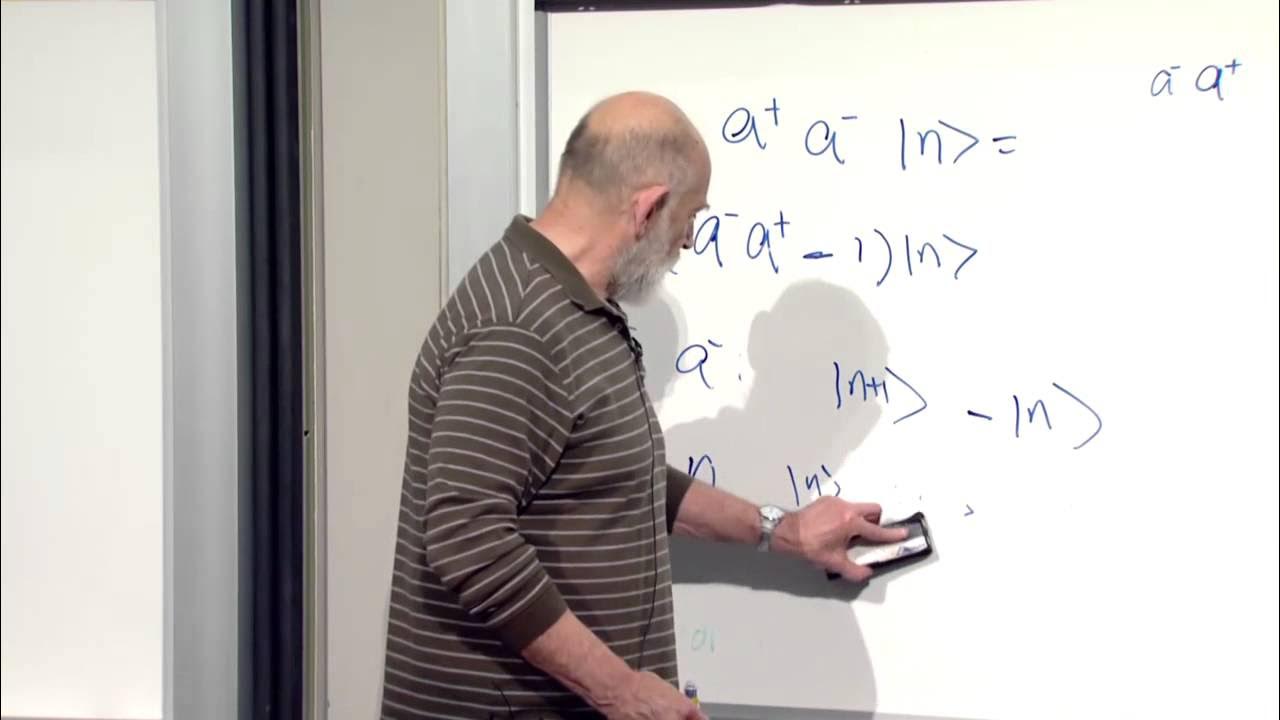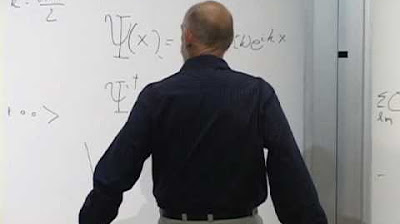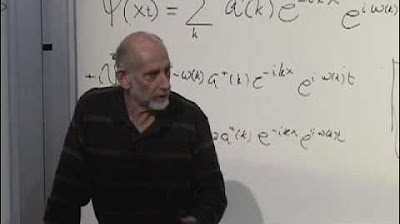Advanced Quantum Mechanics Lecture 7
TLDRThe video script is a detailed lecture on quantum field theory, delivered by a professor at Stanford University. It begins with an introduction to the concept of quantum fields as a tool to study systems with varying particle numbers, such as photons emitted by light bulbs or particles resulting from decay processes. The lecturer emphasizes the abstract nature of the mathematics involved and encourages a slow and methodical approach to understanding. The discussion covers the transition from single-particle quantum mechanics to a framework that accommodates any number of particles. It introduces creation and annihilation operators, which are essential for quantum field theory, and the Fock space, named after the Russian physicist Vladimir Fock. The lecturer delves into the definition and interpretation of field operators, which are used to create or annihilate particles at specific positions, and how these operators act on the state vector of a quantum system. The script explores the relationship between quantum fields and particles, touching on the probabilistic nature of quantum mechanics and the expectation values of observables like particle density and energy. The lecturer also discusses the Hamiltonian of the system, which represents the total energy and is derived from the field operators. The connection between quantum fields and classical fields is briefly mentioned, highlighting how quantum fields can exhibit properties like interference, which classical fields do not. Towards the end, the lecturer hints at the application of these concepts to particle physics processes, such as particle decay and scattering, promising a continuation of the topic in subsequent lectures. The summary underscores the complexity and foundational nature of the material, aiming to provide a clear starting point for those interested in the subject.
Takeaways
- 📚 The concept of quantum fields allows for the study of particle systems with varying numbers of particles, which is essential for understanding phenomena where particle numbers can change, such as particle decay or interactions with light.
- 🚀 Quantum fields are introduced as a flexible tool to describe both the quantum mechanics of a fixed number of particles and situations where the number of particles is not fixed.
- 🌟 The field operator is represented by a large capitalized letter and is an operator acting on the space of states of a many-particle system, as opposed to a wavefunction which describes a single particle.
- 🔍 The field operator at a point X can be interpreted as a creation operator for a particle at that point, providing a new perspective on how particles can be created or annihilated at specific locations.
- 🧮 The total number of particles in a quantum system can be represented as an operator, which is the sum over all modes of the number operator for each mode, reflecting the quantized nature of particle occupation in energy states.
- 📊 The density of particles, or the number of particles in a small volume, can be described by an operator, which corresponds to a measurable quantity in quantum mechanics.
- ⚖️ The Hamiltonian for a system of non-interacting particles can be constructed from the field operators, providing a way to calculate the total energy of the system.
- 🔧 The energy density, which is integral to calculating the total energy of a system, can be derived from the field operators and is a measurable quantity in quantum field theory.
- 🤔 The notion of particle momentum in quantum field theory is analogous to classical physics, where the momentum operator for a field can be defined, and its expectation value calculated for a given state.
- 🤓 Dirac's notation and the bra-ket formalism provide a powerful and compact way to represent quantum states and their interactions, which simplifies calculations and understanding in quantum mechanics.
- 🌐 The formalism of quantum field theory bridges the gap between particle descriptions and wave descriptions, showing that particles are quanta of underlying quantum fields, thus resolving early confusions about the nature of quantum mechanics.
Q & A
What is the fundamental concept behind introducing fields in quantum mechanics?
-The fundamental concept behind introducing fields in quantum mechanics is to have a flexible tool that can study any number of particles, including situations where the number of particles can change. This is important because in real life, the number of particles, such as photons, can change due to processes like emission, decay, or interactions.
How does the field operator differ from a single particle wave function?
-The field operator is an operator that acts on the space of states of a many-particle system, containing creation and annihilation operators. It is not a wave function nor a state vector for a single particle. In contrast, a single particle wave function describes the state of one particle and is used in single particle quantum mechanics.
What does the integral of the field operator acting at a position X on the vacuum state represent?
-The integral of the field operator acting at a position X on the vacuum state represents the creation of a particle at position X from the vacuum. This provides a new interpretation of the field operator as a creation operator for a particle at a specific point in space.
What is the significance of the operator representing the total number of particles?
-The operator representing the total number of particles is significant because it is an observable quantity that can be measured in a quantum system. It sums over the number of particles in each mode or energy level, providing a way to calculate the total particle count in a system.
How is the energy of a quantum field related to the energy of the individual particles within it?
-The energy of a quantum field is typically related to the energy of the individual particles within it by being the sum of the energies of all the particles. However, in quantum field theory, the energy is represented by an operator that is a function of position and can be measured as an observable quantity.
What is the connection between the quantum field and classical field theory?
-The connection between quantum field theory and classical field theory lies in the fact that expectation values of quantum fields follow the same equations of motion as their classical counterparts. When particles are numerous and in the same state, quantum fields tend to behave like classical fields.
What is the role of the Dirac notation in quantum mechanics?
-The Dirac notation, also known as bra-ket notation, is a formalism that simplifies the mathematical expression of quantum mechanics. It allows for a compact representation of state vectors and operators, making calculations and the understanding of quantum mechanics more straightforward.
How does the concept of 'occupation numbers' help in characterizing a many-particle state?
-Occupation numbers help in characterizing a many-particle state by specifying how many particles there are with each energy level. They provide a way to describe the distribution of particles across different energy states in a multi-particle system.
What is the role of the annihilation and creation operators in quantum field theory?
-Annihilation and creation operators are fundamental to quantum field theory. The annihilation operator removes a particle from a given energy state, while the creation operator adds a particle to a state. These operators allow for the manipulation of particle states and are essential for describing processes where the number of particles changes, such as particle creation and annihilation.
What does the Hamiltonian operator represent in the context of quantum field theory?
-In quantum field theory, the Hamiltonian operator represents the total energy of the field. It is an observable quantity that, when measured, gives the energy of the system. The Hamiltonian is derived from the energy densities associated with the field and is used to describe the dynamics of the system.
How does the concept of 'energy density' relate to the total energy of a quantum field?
-The energy density in a quantum field is the amount of energy per unit volume. By integrating the energy density over all space, one can calculate the total energy of the quantum field. This concept is useful for understanding how energy is distributed throughout the field.
Outlines
📚 Introduction to Quantum Fields
The paragraph introduces the concept of quantum fields as a tool to study particles. It discusses the flexibility required to consider varying numbers of particles and the transitions between different particle states. The speaker emphasizes the abstract nature of the mathematics involved and the importance of a gradual approach to understanding.
🚀 Quantum Fields and Particle Probability
This section delves into the quantum field theory, explaining how wave functions relate to the probability of finding a particle at a certain location. It also touches on the concept of an orthonormal basis and how it's used to describe a system of particles in various states, including energy eigenstates.
🌟 The Role of Orthonormal Basis in Quantum Mechanics
The paragraph explores the manipulation of orthonormal basis functions and their role in defining quantum states. It explains how these functions can represent different quantum states, such as energy levels, and how they are used to express the Dirac Delta function, which is crucial in quantum field theory.
🧬 Characterizing Multi-Particle States
The focus shifts to characterizing states involving multiple particles, each with specific energy levels. The concept of occupation numbers is introduced to denote the number of particles at each energy level. The paragraph also discusses the creation and annihilation operators that act on these states, akin to raising and lowering the energy levels.
🤔 The Field Operator and Its Interpretation
This section introduces the field operator, which is distinct from a wave function and is used to describe the quantum state of a system. The field operator is defined in terms of creation and annihilation operators and is shown to be connected to Fourier transforms, particularly when considering free particle wave functions.
🔬 Quantum Field Operators and Observables
The paragraph discusses the properties of quantum field operators, their hermitian conjugates, and how they can be used to define observable quantities such as the total number of particles in a system. It also explores the concept of the quantum mechanical probability density and how it relates to the observable particle number.
📈 Particle Density and Energy in Quantum Fields
The discussion moves to the concept of particle density and energy in the context of quantum fields. It explains how the integral of the field operator's hermitian conjugate represents the total number of particles, and how this can be interpreted as a density of particles in a given volume.
🌌 Non-Relativistic Particles and Energy Expressions
This section focuses on the approximation for systems with non-interacting, non-relativistic particles, where the total energy is the sum of the energies of individual particles. It also touches on the concept of energy levels (Ω) as solutions to the time-independent Schrödinger equation.
🧲 The Hamiltonian and Energy Density in Field Theory
The paragraph introduces the Hamiltonian in the context of field theory, showing how it can be expressed in terms of field operators. It also discusses the concept of energy density and how it can be derived from the Hamiltonian, leading to an expression that is integral over space.
🔍 Quantum Fields and Classical Field Theory
The final paragraph connects quantum field theory to classical field theory, emphasizing how expectation values in quantum mechanics follow classical equations of motion. It also discusses the formalism of quantum mechanics and its ability to recover single-particle quantum mechanics within a multi-particle framework.
🤓 Dirac's Notation and Quantum Mechanics
This section reflects on the elegance and power of Dirac's notation in quantum mechanics, which simplifies calculations and reduces the chance of errors. It also touches on the historical confusion surrounding the interpretation of wave functions and the connection between particles and waves, which is resolved through quantum field theory.
🏗️ Momentum in Quantum Field Theory
The paragraph concludes with a discussion on the concept of momentum in quantum field theory. It addresses how fields carry momentum and how this can be quantified through operators, drawing parallels to classical concepts of force and energy transfer.
🔬 Observables and Expectation Values in Quantum Systems
The final section distinguishes between operators and expectation values in quantum mechanics, emphasizing the need for a specific state to calculate expectation values. It sets the stage for future discussions on particle physics processes and their representation using field operators.
Mindmap
Keywords
💡Quantum Field
💡Wave-Particle Duality
💡Quantum Mechanics
💡Probability Density
💡State Vector
💡Harmonic Oscillator
💡Fock Space
💡Annihilation and Creation Operators
💡Field Operator
💡Number Operator
💡Hamiltonian
Highlights
Introduction to the concept of quantum fields as a tool to study particles and their interactions, including the creation and annihilation of particles.
Explaining the dual perspective of starting with particles and reconstructing fields or vice versa to understand quantum mechanics.
Discussion on the need for a flexible tool to study quantum mechanics that can handle a variable number of particles.
Explanation of state vectors and wave functions in the context of single-particle quantum mechanics.
Introduction of orthonormal basis and eigenvectors of Hermitian operators in quantum states.
Derivation of the Dirac Delta function using an orthonormal basis and its significance in quantum mechanics.
The concept of Fock space as the space of states for a many-particle system and its importance.
Explanation of creation and annihilation operators and their role in quantum field theory.
Interpretation of the field operator as a creation operator for a particle at a point in space.
Discussion on the total number of particles in a quantum state and its relation to the probability density.
Calculation of the particle density as an observable quantity in quantum field theory.
Derivation of the energy operator for a quantum field and its relation to the Hamiltonian.
Explanation of how the energy of a field is represented in terms of field operators and its significance.
Discussion on the classical limit of quantum fields and how expectation values of quantum fields follow classical equations of motion.
Introduction to the concept of momentum in quantum field theory and how it relates to observable phenomena.
Explanation of the connection between quantum fields and classical fields, particularly in the context of the electromagnetic field.
Discussion on the role of quantum field theory in understanding processes like particle decay and scattering.
Transcripts
Browse More Related Video

Advanced Quantum Mechanics Lecture 6

Lecture 2 | New Revolutions in Particle Physics: Basic Concepts

Lecture 3 | New Revolutions in Particle Physics: Basic Concepts

Lecture 4 | New Revolutions in Particle Physics: Basic Concepts

Advanced Quantum Mechanics Lecture 9

Lecture 1 | New Revolutions in Particle Physics: Standard Model
5.0 / 5 (0 votes)
Thanks for rating: